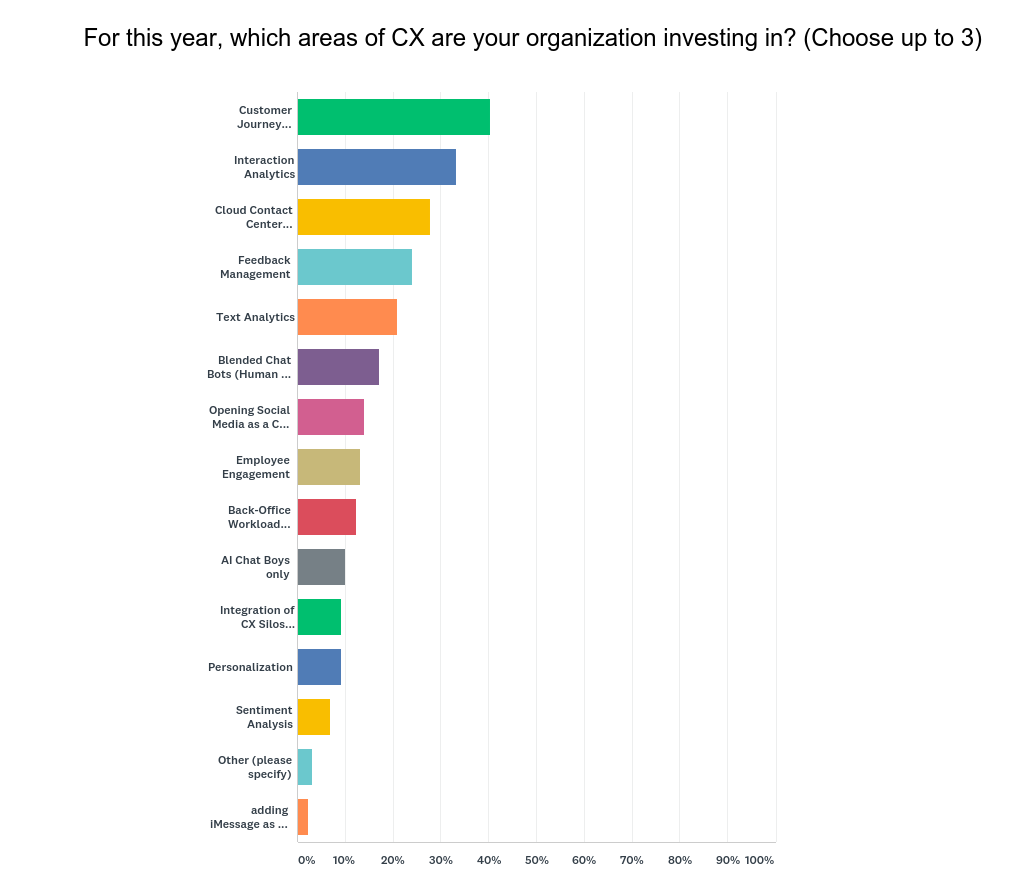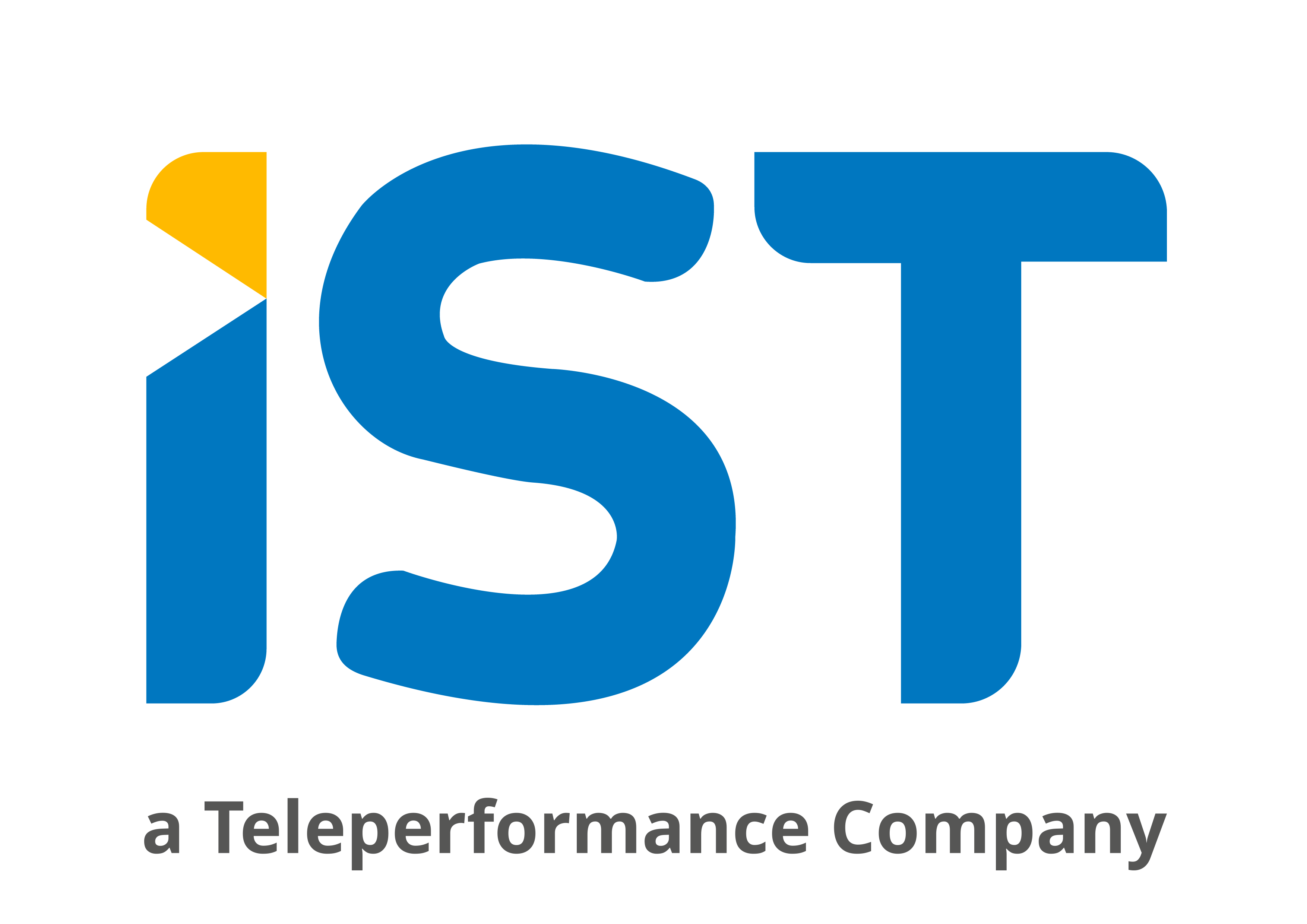It’s a known fact that Customer Experience (CX) is the new battlefield for today’s digitally savvy customers. Rival products and Services can be copied easily within six months, but good customer experience takes years to master and leaves a bigger footprint in customer’s memories. CX is what gives an organization its competitive edge.
With so many CX technologies to choose from, selecting the correct one for your industry and your type of customer is essential to get right. IST, conducted a survey during the Genesys 2018 G-Summit Middle East and the 2018 Verint Engage: On the road Middle East, where we asked 129 organizations the following question: For 2018, Which areas of CX are your organization investing in? Each organization can select up to 3 responses. Results shown below.

All respondents are from a mix of industries and are either medium or large enterprises. All had an existing contact center in place and a CX strategy. For the purposes of the is article, we will be concentrating on the top 4 answers: Customer journey analyticsInteraction analyticsCloud contact center migrationFeedback management. The first two, customer journey analytics and interaction analytics share many common features and overlap on many fronts, for this reason, we will be grouping these together. The third and fourth answers will be analysed as they are. Now, let’s take a look at which CX technologies are Middle Eastern companies investing in.
Simply, Customer Journey Analytics are the tools and processes used to monitor and analyse the way a single customer interacts with your organization via different touch points.
Customer Journey mapping is not new, back in the day, it could have been a simple hand-drawing on a chalkboard, where the customer journey is mapped across the entire customer life-cycle to the various parts of the organization, from buying, searching, asking for help to post sales support. Pain points are found manually and thus solutions are developed to alleviate this.
Now, we live in a world were we have artificial intelligence (AI), were it can automate and analyze the customer journey in a fraction of a second and come up with detailed recommendations. According to Gartner:
“These tools build a customer profile based on known attributes — value, loyalty, product preferences, locations — and layer on how they behave over time in digital channels or stores. Any data scientist will see the value of such information, gathered from enough individuals, to marketings’ efforts to improve offers, messages, timing and sales.”
What percentage of customers takes a certain path? Which steps did the customer take to purchase a product prior to the call?Which steps did customer take that resulted in a non-purchase?When is the best time to interact with a given customer? What is the best channel to interact with the customer?What are the other paths does the customer take? What kind of customer (personas) take certain paths?How do we add value for each client in a given context? The answers to the above are now determined by customer journey tools and Artificial Intelligence, meaning virtually instant analysis and almost real-time recommendations to your customer facing agents. According the Zendesk:
“A successful customer journey will make 55% of customers to recommend a company due to it’s outstanding service more than the product or price. This helps in achieving a bigger market share and a stronger brand image”.
For Customer Journey Analytics to work, it will depend on Interaction Analytics. Interaction Analytics is the process of transforming vasts amount of raw customer interaction data, such as contact center, email, social and web-chat interactions into structured data that can then be analyzed by both AI and human input.
Root causes of areas that consumers are dissatisfied with; Hot topics that consumers engage with the most. This is very effective for an organization’s social media channels; Changing trends in consumer behavior; ‘Deep dive’ into each agent’s knowledge and skill gaps, for training and evaluation; Identify the most effective practices that work the best with consumers.
Cloud Contact Center Migration:
Migrating to cloud contact centers, is what most organizations are doing to achieve a more cost effective, scalable, flexible and secured experience. Cloud contact centers are effective solutions that work the same way as the traditional ‘On-Prem’ ones, except, they don’t take up much space, takes less time to install and set up, and requires very little cost expenditure to get started.
It also provides great flexibility when it comes to extending your contact center to increase call capacity, should market conditions dictate. Cloud contact centers are an all-in-one, powerful and innovative solutions that are easy to set-up for any organization:
Lightning Fast Deployment
Cloud Speed: New 3rd Party CX Product releases are often released on the cloud first, so you get them instantly. Compare this to on-premise solutions, this can take between 1-2 years.
Updates: Software Releases on the Cloud are instant. You can take advantage of new features instantly. On-premise product releases are often annual and requires downtime to upgrade.
Cost Effective: Works through an OPEX model, which is a monthly subscription service. This helps in forecasting monthly and yearly costs.
Flexible: organizations only pay for what they use. You can scale up or down according to market conditions, unlike on-premise solutions.
Security: All data is stored on Amazon’s AWS servers, which is one of the most secure cloud platforms in the world, that are PCI compliant.
Enterprise Feedback Management:
Without knowing where we are, or what is wrong? How can we improve? This is the basis of Feedback management solutions. These solutions go beyond the standard, as they conduct surveys using one single channel (such as web-chat) to assess how this channel is performing. This isolation removes the noise from other channels, so feedback data is normalized before analysis. For example, prior to a customer leaving a branch, the customer will receive a SMS asking about their experience with the store – this will isolate this channel only. Another customer what was on web-chat, will get a call from the contact center for user feedback on that channel only.
The below are different data sources, that enterprise feedback management solution can do for your organization:
Collect data
From different sources, it’s a known that customers have survey fatigue, which usually means the end customer is bombarded by multiple companies asking for their feedback, so most customers skip this part to take the survey. Organizations usually end up with 5-10% of reply back to their surveys; So to get a REAL picture of your customer service, companies can increase the sample size and use multiple channels to collect the surveys, then combine the data; Normalize the data so it makes sense when comparing them across answers from different surveys, as the format of the question on different channels might vary by the nature of that channel; Aggregate data to give a holistic view of your customer.
Conclusion
It is no surprise to IST that the customer journey and analytics scored highly on our survey. Trying to predict what the customer will do next, so you can prepare for them is one of the toughest challenges faced by companies today. By understanding the customer journey and using reliable customer interaction data to predict what will happen, can only help companies to deliver exceptional customer experience and get back their competitive edge. Migrating to cloud has been on the horizon for around 5 years now, but it is only today that the technology, infrastructure and cost has made it a sensible option. We all understand the benefits of cloud, now it’s time to migrate and look forward to the future of CX delivery.
Feedback Management is essential to fully understand what a particular channel is doing for your organization. If it’s not performing, you need to know why and fix the problem. Too many organizations make decisions based on surveys that were not designed for that purpose, meaning decisions are made on false data, which is of course very dangerous.
About IST
IST is an Award Winning Customer Experience (CX) Systems Integrator dedicated to delivering localized CX Solutions to all verticals within the Middle East, Turkey and the UK. IST employs over 250 personnels, across six countries, making IST the largest dedicated CX Solution provider in the region. IST’s portfolio of products and services include: Contact Centers (Cloud, Hybrid or On-Prem), Customer Engagement Systems (Cloud or On-Prem), Contact Center Agent Desktops, Sentiment Analysis, Speech and Language (Arabic & English), Mobile Transactional Security, Digital Signage, Workforce Management, Workload Distribution, Customer Journey Analytics, and many more. IST has received many industry awards by leading experts in an number of key areas: Innovation & R&D, Service Delivery, Project Implementation and Customer Satisfaction.


